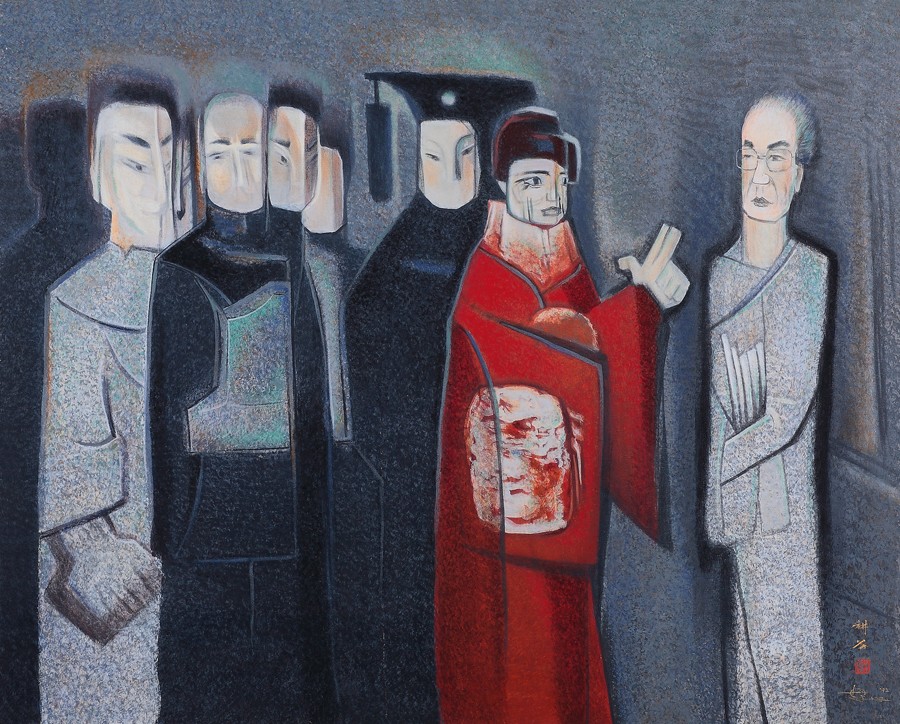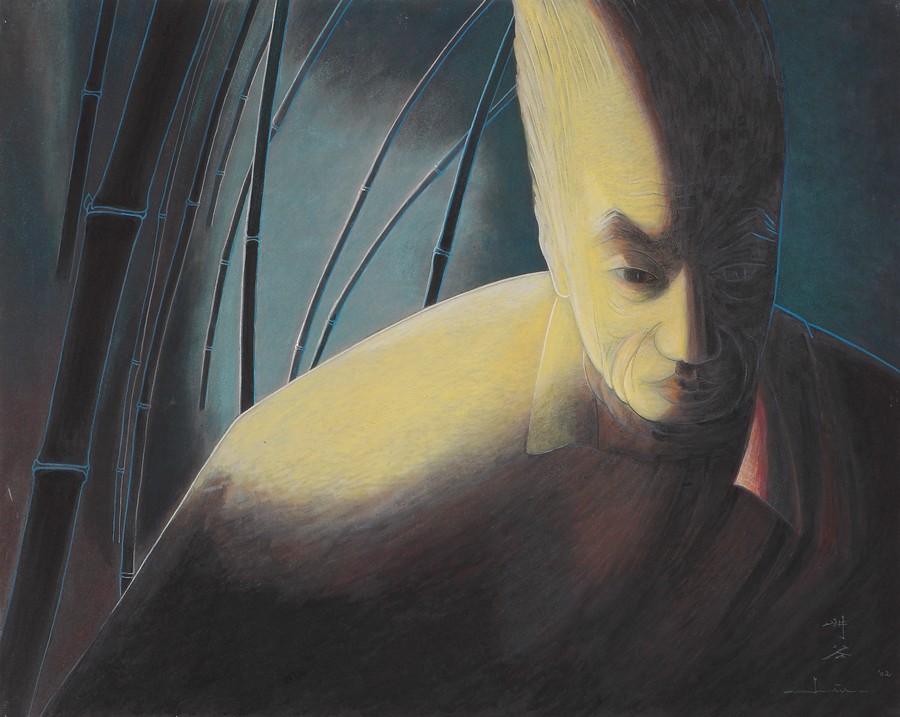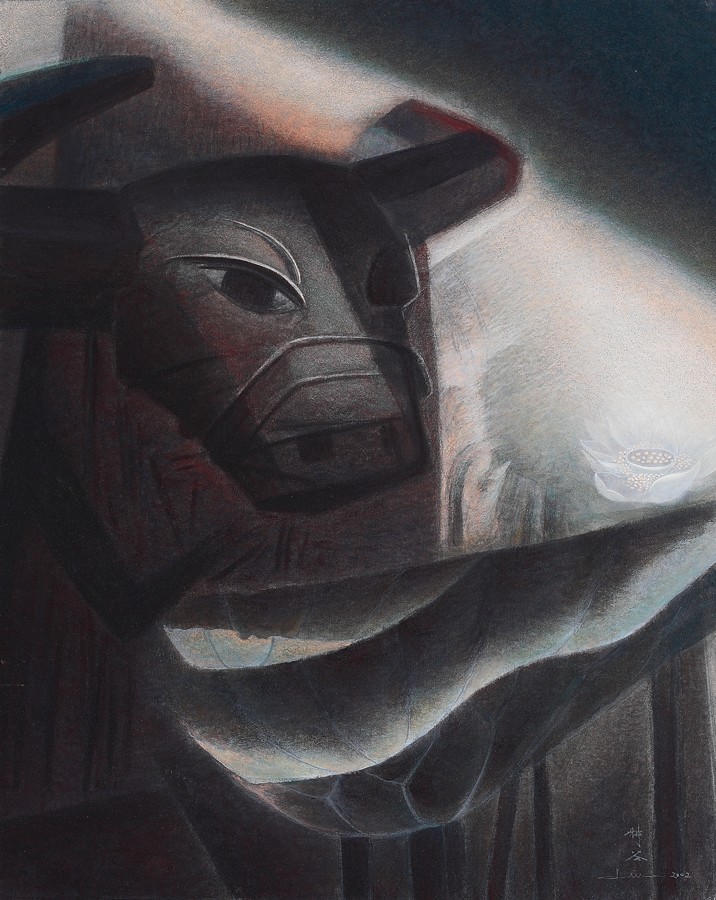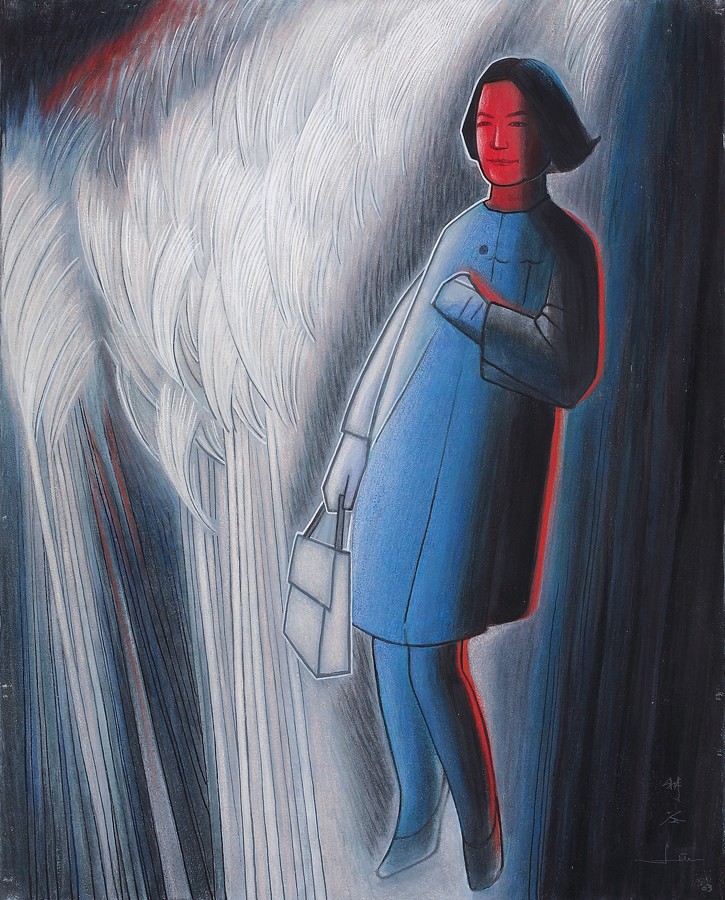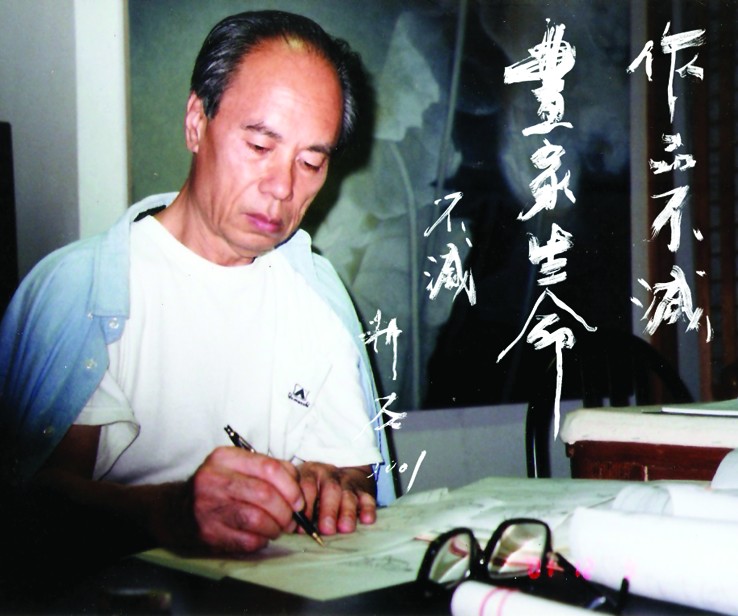
LIU GENG-GU(1940-2006)
Ta-Tung Elementary School, Chiayi Country
Dongshi Junior High School, Chiayi Country
Dongshi High School, Chiayi Country
Xiamen University Fine Art Department.
COLLECTION
| 1988 | Art work, Song of My Land, was collected by National Taiwan Museum of Fine Arts. |
| 1992 | Art work, Rare View of the Gorge, was collected by National Taiwan Museum of Fine Arts. |
| 1995 | Art work, Blossom, was collected by Taipei Fine Arts Museum. |
| 1998 | Art work, White Mt. Jade, was collected by Chiayi Municipal Cultural Center. |
| 2003 | Art work, Resonance, was collected by Fine Arts Center of Tamkang |
EXPERIENCE
| 1986 | Receives the gold medal for the mural contest of National Taiwan Museum of Fine Arts (Song of My Land) 1260x820cm. |
| 1990 | Appointed as judge of 45th Taiwan Provincial Fine Arts Exhibition. |
| 1993 | Appointed as judge of National Taiwan Museum of Fine Arts. |
| 1993 | Appointed as judge of 48th Taiwan Provincial Fine Arts Exhibition Association. |
| 1994 | Appointed as judge of 49th Taiwan Provincial Fine Arts Exhibition Association. |
| 1995 | Appointed as judge of Taipei Fine Arts Museum. |
| 1996 | Appointed as judge of Taichung Da Dun Fine Art Exhibition. |
| 1996 | Appointed as judge of Nan Ying Award for Tainan City Government. |
| 1996 | Appointed as judge of Taiwan Provincial Fine Arts Exhibition Association. |
| 1998 | Appointed as judge of National Taiwan Arts Education Center from Taiwan Ministry of Education. |
| 1998 | Appointed as judge of Nan Ying Award for Tainan City Government. |
| 1998 | Appointed as judge of Huangxi Exhibition of Changhua County. |
| 1999 | Appointed as judge of Nan Ying Award for Tainan City Government. |
| 2000 | Appointed as judge of 14th Nan Ying Award for Tainan City Government. |
| 2000 | Appointed as judge of Taichung Da Dun Fine Art Exhibition. |
| 2002 | Appointed as judge of Kaohsiung Fine Arts Museum. |
| 2002 | Appointed as judge of Greenwater Society. |
| 2003 | Appointed as judge of Kaohsiung Fine Arts Museum. |
| 2004 | Appointed as member of preparatory committee of National Taiwan |
| 2004 | Appointed as consultant of Taiwan Provincial Fine Arts Exhibition. |
| 2005 | Appointed as judge of DEPO Education Foundation Exhibition. |
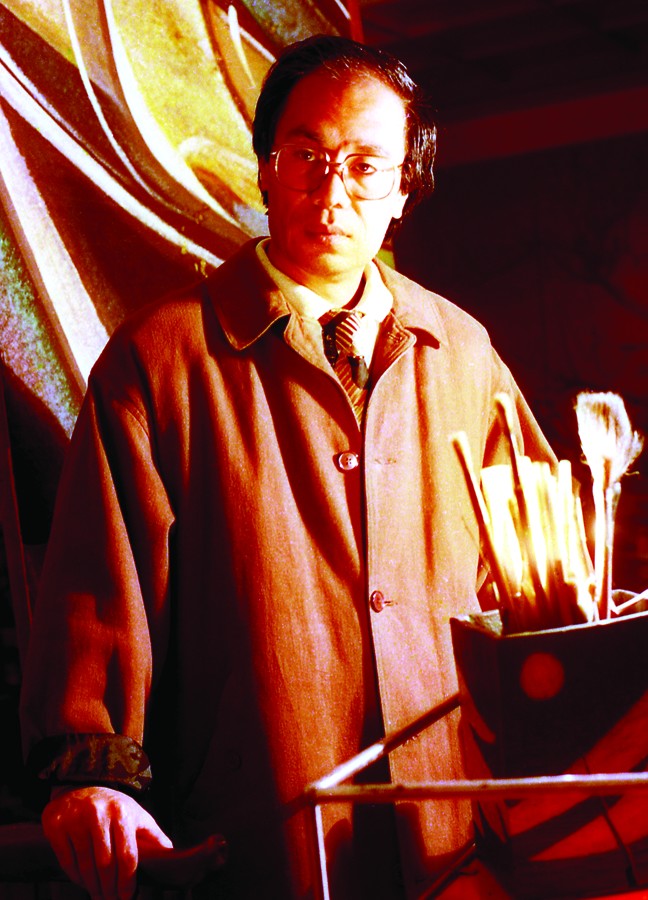
SOLO EXHIBITIONS
| 1990 | Solo Exhibition, invited by the National Taiwan Museum of Fine Arts. |
| 1990 | Solo Exhibition, invited by the Taichung Modern Gallery. |
| 1991 | Solo Exhibition Invited from Gingwa Art Center in Taipei Airport. |
| 1992 | Solo Exhibition, invited by Taipei Mitsukoshi collaborated with Gingwa Art Center in Taipei Mitsukoshi Cultural and Educational Foundation. |
| 1993 | Solo Exhibition invited by Taiwan Master Artist Status Society. |
| 2012 | Solo Itinerant Exhibition around Taiwan, invited by the Soka Gakkai International Taiwan. Breakthroughs and Transformations—The Art of Eastern Gouache Painting by Liu Geng-Gu. |
| 2016 | Solo Exhibition, invited by the National Dr. Sun Yat-sen Memorial Hall—Land, Humanity, and Nature’s Majesty. |
| 2017 | Sole Exhibition, invited by Sincere Art Gallery–An Artist’s Spirit is Immortalised Through His Works. |
| 2019 | Solo Exhibition, invited by the Taichung City Government Cultural Affairs Bureau, Taichung City Seaport Art Center-Unveiling the Culmination of My Conviction—Liu Geng-gu’s Gouache Retrospective Exhibition. |
| 2020 | Solo Exhibition, invited by Chan Liu Art Museum- Integration of Ancient and Modern-The 80th Birthday Anniversary Retrospective Exhibition of Gouache Master Liu Geng-gu’s Art. |
JOINT EXHIBITIONS
| 1985 | Group Exhibition, participated in the Asia Art Exhibition in Tokyo ( Ingeniousness ) |
| 1985 | Group Exhibition, participated in the Celebrity of Taiwan Exhibition ( Fragrance ) |
| 1992 | Group Exhibition Invited by the Taiwan Tai-Yang Art Society at Taipei International Convention Center. |
| 1992 | Group Exhibition, invited by the Taiwan Gallery Expo at Taipei World Trade Center. |
| 1993 | Group exhibition invited by the Greenwater Society in Goethe Art Center. |
| 2000 | Group exhibition, Master of gouache painting exhibition 2000 , invited by the Taichung City Government. |
| 2004 | Group exhibition in Feng Chia University. |
| 2006 | Group exhibition in Chin Shi Fine Arts Center. |
| 2015 | Group exhibition in Taipei 101. |
AWARDS
| 1957 | Receives the Gold Medal of Fine Arts from Chiayi county. |
| 1958 | Receives the Gold Medal of Chinese Painting from Taiwan. |
| 1959 | Receives the Judges’ List Award of Chinese Painting from 13th Taiwan Provincial Fine Arts Exhibition. (Botanical Garden in Summer) |
| 1961 | Receives the Judges’ List Award of Chinese Painting from 15th Taiwan Provincial FineArts Exhibition. (Blossoms) |
| 1961 | Receives the Judges’ List Award of Chinese Painting from 15th Taiwan Provincial FineArts Exhibition. (Blossoms) |
| 1981 | Receives the bronze medal for Gouache Painting from 44th Taiwan |
| 1981 | Receives the Quality Award of Gouache Painting from 36th Taiwan |
| 1982 | Receives the silver medal for Gouache Painting from 45th Taiwan |
| 1982 | Receives the gold medal for Gouache Painting from 37th Taiwan |
| 1983 | Receives the gold medal for Gouache Painting from 46th Taiwan |
| 1983 | Receives the bronze medal for Gouache Painting from 38th Taiwan |
| 1984 | Receives the bronze medal for Gouache Painting from 47th Taiwan Tai-Yang Art Society Exhibition. (The Flower God of June) |
| 1984 | Receives the silver medal for Gouache Painting from 39th Taiwan |
| 1985 | Receives the Honor of Master Artist Status from Taiwan |
| 1986 | Receives the gold medal for the mural contest of National Taiwan Museum of Fine Arts (Revelation) |
| 1986 | Receives the gold medal for the mural contest of National Taiwan Museum of Fine Arts (Song of My Land) 1260x820cm. |
| 1991 | Receives the Commemorative Medal from Chinese Writers’ and |
| 2005 | Receives the Honor Certificate from National Taiwan Arts Education Center. |
Night Waves on the Cape
Taiwan’s northern coast was one of the scenic spots that Liu in his early years had often visited with his friend, the painter Lü Chi-cheng, and he showed a unique grasp of this beautiful area. In this painting, Liu arranged the composition with large crossing diagonals. His depiction of the waves crashing against the rocky shore is firm and natural in its grasp of the forms, and it convincingly conveys the water’s movement. The palette is gentle and varying, and there is the suggestion of adventure in capturing the interplay between the rocks and waves. In the midst of it all, two seagulls are seen looking for food, and the way they fly together imbues the painting with unlimited room for the imagination.
Revelation
This painting combines semi-abstract forms, “V” shapes, overlapping triangles, and complexly woven vertical and horizontal images, a warm, elegant palette, and fantastically dynamic clouds to provide the viewer with a multiply changeable visual space. Negative and positive blocks of color are used, plus lines that subtly echo one another. The artist cleverly combines the images of oxen and of farmers pleased with the harvest. Whether plowing, sowing, threshing, raising animals, or gathering the harvest, their forms dance and are at one with nature. The painting is a tribute to humanity. This painting won First Prize in the first mural competition organized by the Taiwan Museum of Art (now named National Taiwan Museum of Fine Arts).
Migrating Together for a Thousand Miles
Through the use of overlapping areas and positive-negative contrasts, the artist reveals the beauty of geese migrating over long distances. There is a glimmer of light in the darkest reaches of the sky, and in the brighter areas it seems as if one is suspended high in the sky. It embodies the Zen “method of no-method.” This work shows in full the artist’s capability in bringing together strength and beauty in a large work. The artist often compared himself with an isolated goose that flies a thousand miles in a day. This painting also shows the artist’s skill with expressing vibrant, imagined realms in large paintings. Thus, as one examines the painting in greater detail, one increasingly discovers how the artist’s distinctive brush-ideas conceal the beauty of the blending between Western art, with its emphasis on color blocks, and Chinese art, with its emphasis on line.
Adversity Makes a Man Wise
This painting records the artist’s emotional state after he won First Prize in the mural competition held by the Taiwan Museum of Art in 1988. The honor carried a cash award of NT$2 million. Afterward, he came under all kinds of social pressure and suspicion from people who wondered how he could complete an Eastern gouache painting more than 12 meters long on his own, without a team of assistants. This gave him the motivation to complete an even larger work, Hymn of My Land, within three years, as well as a number of other Eastern gouache paintings measuring close to 10 meters at the same time. Examples include In Praise of China’s Caves (1990), In Praise of the Great Toontree That Endures 8,000 Autumns (1991), and The Farmhouse (1992).
Enduring Firm Through a Thousand Autumns
Liu Geng-Gu began his white tree series of paintings in March 1990, after he had visited Mt. Huang and saw the ancient trees growing there. He executed several dozen paintings in various sizes of Mt. Huang, and at the heart of each is a respect for nature. Although the trees are strangely bent, gnarled, and ravaged with age, they have assumed their true forms; they follow the cycle of the seasons and are in spiritual accord with heaven and earth. They are the best illustrations of the Zhuangzi-inspired notions of being “alone in spiritual communion with heaven and earth” as well as “the use of uselessness.” The large tree in this painting occupies four-fifths of the composition. It towers close by, thereby freeing up the perspective, and the white of the tree extends into the white of the drifting clouds. The colors are pure and minimal but skillfully bring out the extreme age of the tree and its smaller companion. Highly sensitive line drawing outlines the tree’s shape throughout. The mineral pigments are thickly applied, forming a distinctive texture.
Peonies
The twelve peony blossoms in this painting include unopened buds and fully open, beautiful blooms. Each is full of grace and radiating purity, and each is special in its own way. There is consistency in the handling of light-dark contrast, and strength is moderated with gentleness. This is a unique aspect of the artist’s peony series. The wash in the background is an example of Liu Geng-Gu’s skillful method whereby he applies gradients of color in grey. Some of the stems and leaves are rendered with the “boneless method” of Chinese art. In every detail, one can see the artist’s confident technique. The contrast between the fully open flowers and the darkness of the night adds depth to this conceptual realm and brings out the sense of hidden beauty.
In Praise of the Great Toon-tree That Endures 8,000 Autumns
This painting continues the exaltation of the natural realm found in the white tree series. It still focuses on a tree set in the near distance, and the artist seeks to unlock the laws of nature. Perceiving the “truth” or “perfection” of things depends on developing a high level of refinement—as Jing Hao (c. 850-c. 920) once said, in his Notes on Brush Methods (Bifa ji), “Measure the images of things and capture their truth … In the ‘true,’ both the qi and the substance flourish.” Liu Geng-Gu’s works are accurate in their depiction of form and have a palpable spirituality. Filling most of the space in this painting, without a doubt, is turbulently flowing qi (sometimes translated as “pneuma”). This qi is not the ‘ether’ of traditional Western thought but the life-endowing qi of the East.
The Hidden Realm May Be Found
Most of Liu Geng-Gu’s self-portraits show him as an elderly man, one who has undergone the tests of time and is calmly contemplating his inner world. In his later period he began to use a great deal of imagistic, suggestive vocabulary to express being in spiritual communion with things. Whether the image is one of bamboo, an ox, or a faint glimmer of light, one can sense the lyricism (expressing feelings with objects) in his mind. Most of these works feature strong diagonals, and they often transform the color of things. Straight, broad brushstrokes and lines crossing plane areas are used to convey the connection between inner and outer worlds—as well as the beautiful concept from the thinking of Laozi and Zhuangzi that the self is not distinct from objects, and the world is one organic whole. Liu also clearly felt a sense of responsibility for upholding his heritage. For example, he was especially fond of bamboo, and he emulated artists such as Wen Tong (1018-1079) and Zhao Mengfu (1254-1322) who sought to make nature their teacher. Thus in paintings like Viewing a River (2002), The Hidden Realm May Be Found (2002), Adversity Makes a Man Wise<Self-portrait>(1992), and There Is …? (1992), there is always a clump of bamboo, and an expression that reveals the artist’s loneliness and sense of time passing.
Light
During and after the late 1990s, Liu Geng-Gu started a series of paintings in which he sought to express his inner soul. These are freer in terms of their handling of light and conceptualized subject-matter. He had been suffering for many years with cardiovascular disease, but at the same time he always considered himself an inheritor of historical tradition and felt a sense of mission, so he pioneered a technique that combined Chinese and Western approaches to line and color. The dark-light contrasts in these large paintings became sharper and more powerful, and his handling of line reached new heights. The colors are saturated yet elegant, and the images magically vivid. These intoxicating paintings definitely depict the lonely spirit of one who goes his own way.
A Beauty
This painting is based on a photograph that the artist had taken in 1963 of his girlfriend, who eventually became his wife, LiuHuang Mei-hui. This painting is also one of a series of portraits in which the artist drew from his memories, seeking to capture his wife’s beauty from before the time they were married. He thoroughly captures the image and spirit of the subject as she goes out for an autumn stroll—her youthful figure, easy grace, and happiness as she self-confidently walks in the dim light. The darkness of the background serves to highlight her, and the autumnal idea is further conveyed through the blossoming silver grass.
Video






